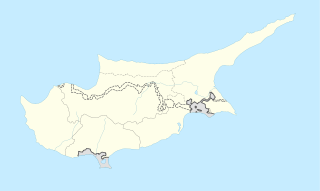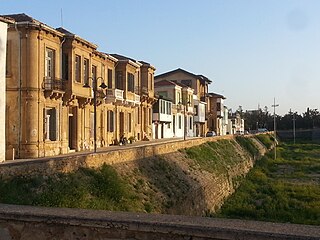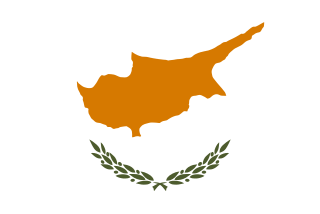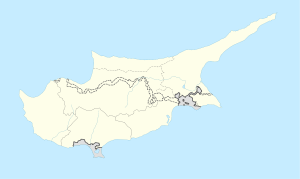
Aglandjia is a suburb and a municipality of Nicosia, Cyprus. The municipality has a population of 20,783 (2011) and is contiguous with Nicosia Municipality.

Engomi is a suburb and municipality of the Cypriot capital Nicosia. In 2011, it had a population of 18,010. Of these, 14,254 were citizens of Cyprus.

Omorfita or Kuchuk Kaimakli is a northeastern quarter of Nicosia, Cyprus. Omorfita has been divided since 1974, its biggest chunk being under the de facto control of Northern Cyprus.

Pallouriotissa is an area of Nicosia, Cyprus, formerly an independent village, which was annexed to the municipality in 1968. It was subsequently divided into the quarters of Panayia (Panagia) and Saints Constantine and Helen. As of 2011, their combined population was 15,607. Pallouriotissa is immediately south of Kaimakli.

Ayios Antonios is a Neighbourhood, Quarter, Mahalla or Parish of Nicosia, Cyprus and the parish church thereof.

Haydar Pasha is a Neighbourhood, Quarter or Mahalle of Nicosia, Cyprus and the mosque situated therein. Both are named after Haydar Pasha, said to be one of the 12 generals in command of divisions of the Ottoman army at the time of the Ottoman conquest of Nicosia. Each general being posted to a quarter, that quarter was known by his name.

Ayioi Omoloyites is a Neighbourhood, Quarter, Mahalla or Parish of Nicosia, Cyprus and the parish church thereof. Its name in Greek is Άγιοι Ομολογητές, which means Holy Confessors and also has the name Ayii Omoloyitades used in older English language works and Turkish.

Tabakhane is a historic neighborhood, quarter, Mahalla, or parish of central Nicosia, Cyprus, named after the tannery which formerly existed just outside the city walls, near Paphos Gate. Its name is the Arabic and Turkish word for tannery.

Yeni Jami is a Neighbourhood, Quarter, Mahalla or Parish of Nicosia, Cyprus and the mosque situated therein after which the Quarter is named. It is spelled Yenicami in Turkish and Γενί Τζαμί in Greek and means "new mosque" in Turkish.

Ayios Kassianos is a Neighbourhood, Quarter, Mahalla or Parish of Nicosia, Cyprus and the church situated therein after which the Quarter is named. It is Άγιος Κασσιανός in Greek and Aykasyano in Turkish and also has the historic name Kafesli . At the last Census (2011) it had a population of 315,.

Taht-el-kale is a neighbourhood, quarter of Nicosia, Cyprus and the mosque situated therein.

Ayios Loukas is a Neighbourhood, Quarter, Mahalla or Parish of Nicosia, Cyprus and the parish church thereof. The church was dedicated to and named after St. Luke the Apostle and the parish or neighbourhood was named after the church. It is Άγιος Λουκάς in Greek and Ayluka or the new name Ayyıldız in Turkish.

Ak Kavuk is a Neighbourhood, Quarter, Mahalla or Parish of Nicosia, Cyprus and the mosque thereof. It is spelled as Akkavuk in Turkish and Ακ Καβούκ or Άμπου Καβούκ in Greek. Both alternative names appear in English. Jeffery uses both, while the Cyprus Gazette in 1923 uses the form "Abou Kavouk".

Arab Ahmet is a Neighbourhood, Quarter, Mahalla or Parish of Nicosia, Cyprus and the mosque situated therein. Both the Quarter and the mosque are named after Arab Ahmet Pasha, one of the Turkish commanders in the Ottoman conquest of Nicosia. It is spelled Arabahmet in Turkish and Άραπ Άχμετ in Greek.

Ayios Andreas or Tophane is a Neighbourhood, Quarter, Mahalla or Parish of Nicosia, Cyprus. In September 1945, the Ottoman name of Tophane was changed to Ayios Andreas, but there is no parish church of that name.

Iplik Bazar–Korkut Effendi is a Neighbourhood, Quarter, Mahalla or Parish of Nicosia, Cyprus. It lies in the centre of the walled city.

Köşklüçiftlik is a quarter of North Nicosia in Northern Cyprus. In 2011, it had a population of 2,939.

Nicosia within the city limits is divided into 29 administrative units, according to the latest census. This unit is termed in English as quarter, neighbourhood, parish, enoria or mahalla. These units are: Ayios Andreas, Trypiotis, Nebethane, Tabakhane, Phaneromeni, Ayios Savvas, Omerie, Ayios Antonios, St. John, Taht-el-kale, Chrysaliniotissa, Ayios Kassianos (Kafesli), Kaïmakli, Panayia, St Constantine & Helen, Ayioi Omoloyites, Arab Ahmet, Yeni Jami, Omorfita, Ibrahim Pasha, Mahmut Pasha, Abu Kavouk, St. Luke, Abdi Chavush, Iplik Pazar and Korkut Effendi, Ayia Sophia, Haydar Pasha, Karamanzade, and Yenişehir/Neapolis. Some of these units were previously independent Communities. Ayioi Omoloyites was annexed in 1944, while Kaïmakli and Omorfita were annexed in 1968. Pallouriotissa, also annexed in 1968, was subsequently divided into the neighbourhoods of Panayia, and St Constantine & Helen.

Nebethane is an historic neighbourhood, quarter, Mahalla, or parish of central Nicosia, Cyprus,. Its name inherited from the Ottoman period is Turkish for police station or the guard room of the Turkish patrol. Nebethane Mesjid in this quarter was the place where the police patrol of the city assembled for changing the guard each day, accompanied by drums and pipes.












